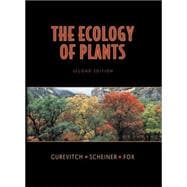Now in full color, this thoroughly revised and updated second edition of The Ecology of Plants incorporates many new illustrations and hundreds of new references. The text covers a range of topics that you might find in a general ecology textbook, but with the focus on the interactions between plants and their environment over a range of scales. Some of the subjects covered are unique to plants, such as photosynthesis and the ecology of plant--soil interactions; other topics, such as resource and mate acquisition, emphasize the distinctive ways plants (in contrast to mobile animals) deal with their environments. The book is unusual in emphasizing the importance of evolutionary and other historical processes for current ecology. Throughout the text, human environmental influences are discussed. While the book is written for an undergraduate college course in plant ecology, the engaging style, thorough coverage of the field, and contemporary perspective make it accessible and useful to others as well, from graduate students in conservation biology to evolutionary biologists and resource managers.
For Instructors
Instructor's Resource CD: This resource includes all the textbook's figures, photographs, and tables, available as JPEGs (high- and low-resolution) and in PowerPoint.








